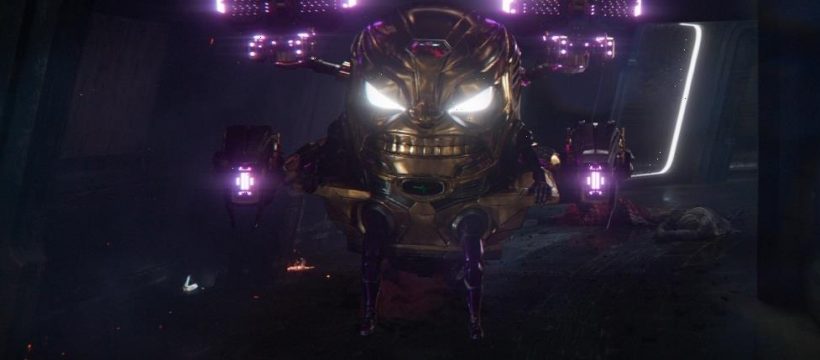SPOILER ALERT: This story discusses major plot points in “Ant-Man and the Wasp: Quantumania,” currently playing in theaters.
The biggest issue “Ant-Man and the Wasp: Quantumania” visual effects supervisors Jesse James Chisholm and Dave Hodgins had in building the robotic villain M.O.D.O.K. was getting the proportions right.
M.O.D.O.K., which stands for Mental Organism Designed Only for Killing, is played by Corey Stoll, the villain from the original “Ant-Man.” As audiences saw at the end of the first movie, his character Darren Cross is microscopically shrunk by Paul Rudd’s Scott Lang, causing massive amounts of damage to his body. He pops up in the third “Ant-Man” movie with a horrifically contorted physique, a giant head and a tiny body. To move, M.O.D.O.K. sits inside a hover chair that doubles as a mechanical suit. “He’s just a massive floating head,” Chisholm says.
In finding the design, Chisholm explains, “We did a lot of studies of putting M.O.D.O.K. next to characters just to see them conversationally, but we realized his eyes were 28 inches apart. Suddenly, we have eyeline issues and looking cross-eyed, and how do we frame this?”
Mark Weinman played the character on set for principal photography and would wear a M.O.D.O.K. face rigged with a hula hoop that had Steadicam rigs and cameras so the team could maintain eyelines. Stoll says, “I had the dots on my face for the performance capture camera.”
They quickly discovered that in animating M.O.D.O.K.’s stretched face “you can lose Corey really quickly.” Chisholm says, “Once you start that stretching, Corey’s head shape is elliptical, so to stretch it out takes him away fast. It was all about scale, retaining his eyes and getting a lot of the scale of his nose. We stretched more of his mouth and face and shrunk his head down.”
Aside from getting the proportion correct, the other challenge was animating M.O.D.O.K.’s movement. Hodgins says, “He’s this large mass, so we had to look at the idea of whether he’s going too fast or too slow. Does he look too light? And there was that eyeline issue, where is he looking?”
The key was to stay close to Stoll’s performance. Hodgins says, “We realized we’ve constrained this person’s head, and a lot of the performance comes from the eyes. A lot of that emotion translates through head nods and body shifts. We spent a lot of time having that discussion, constraining his jaw because he really doesn’t have that much room to move.”
How many versions did it take to nail M.O.D.O.K’s design? Hodgins doesn’t have an exact number, but “it was a lot.”
The VFX supervisors also addressed the conversations that have been surrounding Marvel’s visual effects lately, amid a wave of VFX artists speaking up about alleged poor working conditions for projects produced by Marvel Studios.
Chisholm, who has worked on “Captain Marvel” and “Black Panther,” says, “I feel like working for Marvel, I’m in the NFL. They asked me to do ‘Ant-Man’ and I was like great, these films have all this heart, but I read the script and thought, ‘Holy shit! This is not ‘Ant-Man,’ this is gigantic. I got to play in the Super Bowl. I got to create characters and environments and bring Peyton [Reed]’s movie to life, and it’s really exciting. I feel fortunate to do what I do, and I work my ass off. It’s easy in this climate right now to bash things and that’s the easy way. I don’t know if many people know what we have to do and what it takes to make a movie of this magnitude, but I’m proud of what we accomplished.”

Read More About:
Source: Read Full Article
